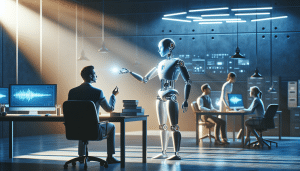Could AI Change the Way You Experience Everyday Life
Aiden Foster November 17, 2025
Curious about how artificial intelligence is becoming part of daily routines? This guide explores practical applications of AI, what machine learning really means, and the surprising ways technology is woven into work, health, creativity, and personal productivity.
The Subtle Reach of Artificial Intelligence
Artificial intelligence, often shortened to AI, is everywhere. From smart speakers in homes to predictive text in messaging apps, AI quietly powers many features people use daily. Machine learning, a technique within AI, helps programs get smarter over time, learning from patterns and improving their accuracy. If you’ve noticed your music streaming app knowing just what you might like next or your email suggesting quick replies, that’s AI at work. This technology continues to evolve, with applications spreading into countless industries and touching nearly every aspect of life (Source: https://ai.gov/).
The beauty of artificial intelligence is how unobtrusive it can be. While it’s easy to notice a new smartphone assistant or voice-operated device, AI is often behind the scenes. It supports driving directions, translates languages on the fly, and even recommends recipes based on what’s in your fridge. For consumers, this seamless integration creates an environment where technology anticipates needs, sometimes before even being aware of them. The reach is broad and isn’t slowing down; developers continually adapt AI in new and creative ways, ushering in innovation at a pace that’s hard to match.
One of the most interesting things about AI is its capacity for personalization. The more data a system receives, the more it can shape services around individual preferences. From online shopping platforms offering product ideas to healthcare apps customizing wellness advice, machine learning analytics make these tailored experiences possible. And all of this takes place with remarkable speed – in seconds, recommendations can go from generic to uniquely relevant. It’s a sign of how embedded AI already is, quietly adapting to each person’s habits, priorities, and interests (Source: https://mit.edu/).
Machine Learning Explained: What Does It Really Do
When news stories mention machine learning, the technology might sound mysterious. At its core, machine learning enables computers to process massive amounts of data, recognize trends, and make predictions without explicit programming. It’s as if computers learn from experience, like humans do. A practical example: email spam filters rely on machine learning to recognize and block unwanted messages by comparing email features to previously identified spam. This process improves with each spam detection, demonstrating how the system continually refines itself (Source: https://www.khanacademy.org/computing/computer-science/ai).
Beyond filtering emails, machine learning is powering breakthroughs in everything from medical diagnosis to weather forecasting. Algorithms sort through millions of records to identify credit card fraud, predict energy consumption patterns, and even flag suspicious transactions at banks. Industries value ML-powered insights for better decision-making and efficiency. For example, during disease outbreaks, machine learning helps researchers detect emerging trends earlier by analyzing online search and social media data. It’s technology that detects faint signals others might miss.
Across sectors, companies are investing in data science teams to unlock deeper value from information. These professionals use sophisticated models and vast datasets to optimize services and create new predictive tools. In healthcare, machine learning helps estimate patient risk and models the spread of infectious illnesses. In urban planning, it allows city leaders to simulate the effects of traffic changes before they’re made. Behind every such advancement, machine learning is demonstrating how technology can tackle complex problems and enhance lives in previously unimaginable ways (Source: https://www.wired.com/tag/artificial-intelligence/).
AI Tools That Make Work Feel Effortless
Workplaces everywhere are being transformed by artificial intelligence-powered tools. Office suites leverage smart suggestions to speed up tasks, such as writing or image editing. Virtual assistants now schedule meetings, organize calendars, and send reminders, making it easier to focus on important priorities rather than repetitive work. Some AI systems even analyze emails or chat conversations to suggest document drafts and automate customer support responses. These upgrades reduce manual burden and make professional routines more efficient (Source: https://hbr.org/topic/artificial-intelligence).
Modern project management platforms utilize machine learning algorithms to flag bottlenecks in teams, forecast project trends, and optimize workloads. Data analytics platforms run predictions in seconds, helping businesses identify key opportunities and make better choices. AI takes care of tedious accounting, HR paperwork, and even cybersecurity monitoring. More companies now explore custom chatbots for handling routine client questions, freeing up staff for strategic problems that require a human touch. The result? More creativity, greater productivity, and a stronger focus on innovation.
Remote work has received a boost from AI as well. Smart video conferencing apps use facial recognition to track speakers, provide live transcriptions, and adjust sound quality on the fly. Intelligent background filters and translation tools break language barriers. For distributed teams, AI-powered cloud platforms keep everything organized, enabling seamless collaboration across time zones. These advancements make it possible for teams to stay connected and productive no matter where they’re based, illustrating the profound effect of AI on modern work (Source: https://www.nature.com/articles/d41586-018-05469-3).
Smart Health and Wellness Powered by Algorithms
Wellness apps and wearable devices are integrating artificial intelligence in ways that were science fiction a decade ago. AI allows fitness trackers to interpret heart rates, assess sleep quality, and suggest workout routines individualized for each person. Healthcare platforms harness machine learning to spot early warning signals for chronic disease by tracking trends in activity, diet, or biometric data over time. Telemedicine platforms utilize AI to triage symptoms, helping patients determine when to seek care or what questions to ask providers (Source: https://jhu.edu/).
On a larger scale, medical researchers use artificial intelligence to sift through data, accelerating the search for drug candidates or the early detection of health risks. This technology transforms how doctors analyze medical images, such as X-rays or MRIs, spotting subtle abnormalities that could be overlooked by the human eye. Remote patient monitoring, especially for those with chronic illnesses, is vastly more effective thanks to predictive analytics. These innovations improve diagnostics, treatment planning, and patient outcomes — all while saving valuable time.
Public health officials and research institutions employ AI-driven models to forecast illness outbreaks, monitor vaccine distribution, and study environmental factors affecting community health. By using aggregated, anonymized data, these models identify hot spots and help allocate resources where they are needed most. These tools are continually improving, providing individuals and communities with strong support for healthier living. Ultimately, the merger of AI and healthcare is opening the door to a future where wellness is monitored and managed in more proactive, precise ways (Source: https://www.ncbi.nlm.nih.gov/pmc/articles/PMC6616181/).
Creative Expression in the Age of AI
Technology is redefining what’s possible for creativity. Artificial intelligence is now an artist’s collaborator, helping generate music, compose poetry, and create digital paintings. AI platforms are used by filmmakers to script scenes or by game developers to design entire worlds algorithmically. Storytellers use AI to review plot consistency and suggest narrative arcs. Even photo editors can now retouch images with a few taps, supported by machine learning models trained on current aesthetics and trends (Source: https://theconversation.com/artificial-intelligence-and-the-arts-195709).
The accessibility of AI to hobbyists and professionals alike is growing rapidly. Anyone can try AI-powered writing assistants, music composition tools, or art generators online for little or no cost. These platforms remove creative blocks, offer instant feedback, and help budding creators refine ideas. Some applications can even mimic famous authors or replicate instrumental styles, providing inspiration that was once out of reach for most people. The democratization of these tools fosters more diverse voices and experimental projects.
With new opportunities, however, come new questions. As AI-generated works become more sophisticated, discussions about originality and intellectual property are heating up. Still, many see artificial intelligence as a catalyst for creative discovery, making collaboration between human intuition and data-driven logic a springboard for innovation. When used ethically and thoughtfully, AI-infused creativity augments human talent, ensuring the future of art and technology is collaborative and filled with possibility.
Productivity and Decision-Making: A Smarter World
Artificial intelligence makes life easier in dozens of subtle ways. Productivity apps rely on machine learning to organize calendars, set reminders, and prioritize important notifications. Smart shopping assistants use natural language processing to answer product questions, find deals, and suggest personalized options based on purchase history. This helps consumers make choices quickly and confidently, freeing up time for what matters most (Source: https://www.pewresearch.org/internet/2022/02/16/the-future-of-digital-spaces-and-their-role-in-democracy/).
Decision-making is enhanced by smart algorithms that analyze options, weigh risks, and highlight trends. Businesses turn to AI-powered tools for market research, customer analysis, and supply chain management. Individuals benefit as well, from travel planning apps that suggest ideal times to book flights to health trackers that issue gentle nudges when it’s time for a break. The common thread? Better data means better decisions, and AI ensures relevant details are delivered just when they are needed.
Of course, technology is no replacement for human judgment. The best AI-guided decisions come when machine recommendations are used alongside critical thinking and intuition. Many tech leaders advocate for ‘human-in-the-loop’ systems that maximize both efficiency and oversight. As reliance on artificial intelligence grows, developing digital literacy skills and understanding algorithmic logic becomes more important. Staying informed, adaptable, and curious ensures everyone can benefit from a smarter world without losing sight of personal values and goals.
References
1. U.S. Government. (n.d.). Artificial Intelligence. Retrieved from https://ai.gov/
2. Massachusetts Institute of Technology. (n.d.). Research Laboratory of Electronics: Artificial Intelligence. Retrieved from https://mit.edu/
3. Khan Academy. (n.d.). Intro to Artificial Intelligence. Retrieved from https://www.khanacademy.org/computing/computer-science/ai
4. Wired. (n.d.). Artificial Intelligence. Retrieved from https://www.wired.com/tag/artificial-intelligence/
5. Harvard Business Review. (n.d.). Artificial Intelligence Section. Retrieved from https://hbr.org/topic/artificial-intelligence
6. Johns Hopkins University. (n.d.). Department of Computer Science: Artificial Intelligence. Retrieved from https://jhu.edu/








